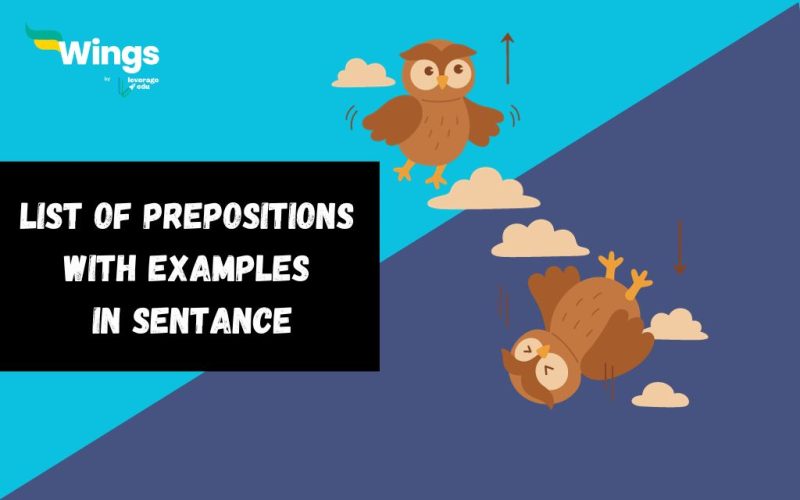List of Prepositions With Examples: Learning from the list of Prepositions is a great way to improve your English vocabulary. These words are mostly used in day-to-day sentences which we might not even know about. However, there is a huge prepositional list you ought to know in English grammar and improve your vocabulary. So, if you wish to learn more about prepositions and their common usage, then you have come to the right blog.
In this blog, you will get to see a list of prepositions with examples, types of them and how each one of them can be used in sentences.
This Blog Includes:
What are Prepositions?
A preposition is a word or rather a group of words which are used before a noun, pronoun or noun phrase. They are used to indicate direction, location, and time, to introduce an object or spatial relationships. Some examples of prepositions include ‘at’, ‘on’, ‘in’, ‘of’ and ‘to’. For example, The woman sat on the chair.
The preposition used in this sentence shows that the man sat ‘on’ the chair.
Also Read: Rules for Prepositions in English Grammar with Examples
11+ Commonly Used List of Prepositions in Everyday Life
Here is the list of prepositions which can be used in sentences.
- About
- Above
- Despite
- Past
- Round
- Since
- Through
- Among
- Beyond
- Opposite
- Unlike
- Underneath
- Within
- Without
Types of Prepositions with Examples
Prepositions are of various types. They can be categorised into several categories. Here is the list of prepositions with examples.
- Prepositions of Time
- Prepositions of Place
- Prepositions of Movement
- Prepositions of Manner
You might now know that types of prepositions can be divided. Therefore, we have compiled a list of prepositions along with their meaning and examples. Below is the list of prepositions that will help you in using them in sentences.
Preposition of Time
| Preposition | Meaning | Example |
| About | In the time following (an event or another period) | I am very concerned about her illness. |
| Ago | Before the present; earlier | I saw him not long ago. |
| After | In the time following (an event or another period of time) | He looked after her baby. |
| Before | During the time of preceding. | She just left before sunrise. |
| At | Expressing location or arrival in a particular place or position | We are at war. |
Also Read: Learn All About Adjectives in English Grammar!
Prepositions of Place
| Preposition | Meaning | Example |
| Aboard | On or Into | I climbed abroad on the yacht. |
| Above | In extended space over and not touching | He held his arms above his head. |
| Amid | Surround by, in the middle of | The investigation comes amid growing concerns. |
| Astride | With a leg on each side | He sat on the chair astride. |
| Among | Situated more or less centrally in the relation | Soon I lost her among the crowd. |
Prepositions of Movement
| Prepositions | Meaning | Examples |
| Away | To or at a distance from a particular place | The will was locked away in the safe. |
| Away from | To distance something from someone | As he drove away from her house, he felt sad. |
| Behind | at or to the far side of (something), typically to be hidden by it. | He hid the treasure behind the tree. |
| Below | At a lower level | The sun disappeared below the horizon. |
| Beneath | Extending or directly underneath | The ground beneath is full of flowers. |
Prepositions of Manner
| Prepositions | Meaning | Example |
| As for | With regard to | As of yesterday, a lot of them must be in the bar. |
| As per | In accordance with | As per yesterday, a lot of them must be in the bar. |
| As to | With respect to | He makes it look so easy as to be ludicrous. |
| Aside from | Apart from | Money continues to be a problem but aside from that we’re all well. |
| Bar | Except for | Her kids were all gone now, bar one. |
FAQs
Prepositions are often used in sentences to refer to something. This can either refer to time, location, movement, spatial relationship etc.
1. Each preposition must have an object.
2. The prepositions must be placed before a noun or a pronoun.
Prepositions usually appear before a noun or pronoun establishing a relationship between nouns, pronouns and other parts of the sentence.
Related Posts
To advance your grammar knowledge and read more informative blogs, check out our Learn English page and don’t forget to follow Leverage Edu.
 One app for all your study abroad needs
One app for all your study abroad needs















 60,000+ students trusted us with their dreams. Take the first step today!
60,000+ students trusted us with their dreams. Take the first step today!

